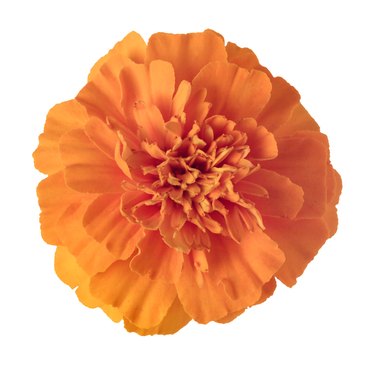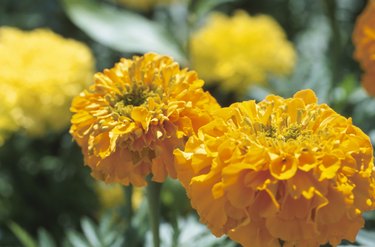
Of all the flowers typically seen in an American garden, the marigold never disappoints. From its resilience, outlasting most other annuals well into the fall months and thriving in even the hottest driest weather, to its intense fiery color, the lowly marigold fills in the bare garden spots more efficiently than many other flowers. Even its name suggests how intensely this humble flower brightens the landscape.
A Marigold By Any Other Name
Video of the Day

A member of the calendula family, the marigold, is also called the herb of the sun, the pot marigold or the French marigold. The English formed the name using Mary, meaning the Mother Ray, and the word "gold." The marigold symbolizes passion and creativity. Despite its limited range of color, it honors these traits by holding its own among other more colorful flowers. Even Shakespeare thought highly enough of this blossom to mention it in one of his plays called "A Winter's Tale."
Video of the Day
Mysticism and Superstition

In Welsh tradition, marigolds were used to predict weather. Closed blossoms meant that bad weather was on the way. Witches and those who practiced the healing arts wore marigolds to keep themselves safe from plague and used the blossoms to stop people from gossiping or speaking ill of others. Marigolds were also believed to encourage more cheerful conversations, and a potted marigold brought inside was thought to restore peace between a disgruntled husband and wife. A potion made from marigold petals was also thought to summon fairies when rubbed on the eyelids of someone sleeping.
Traditions and Legends

Named by the early Christians as "Mary's Gold" in honor of Jesus' mother, the marigold symbolizes simplicity and was used to decorate church altars. Legend holds that Mary used the flowers as coins, and that on her flight into Egypt with Joseph and the infant Jesus, thieves took her purse and when they opened it, marigolds fell out. Another ancient use for marigolds was to weave them together into garlands for weddings as well as use them as love charms.
Practical Knowledge

The pot marigold was named for the practice of using the blossoms in cooking as an inexpensive substitute for the herb known as saffron. Pigments were also commonly extracted from the marigold's petals to be used to dye wool or human hair. Marigold essence was used in potions to fight certain contagious diseases such as measles and smallpox. It was also used in broths for invalids, in healing potions, and in cleansing tonics.
Double-Edged Significance

While the marigold flower, closely associated with the sun's energy, carries positive connotations, it has also been perceived through the ages to possess some darker qualities. It can symbolize jealousy and cruelty and represent sorrow and feelings of unrest during a sad time. Ancient Mexican lore portrayed the marigold as the flower of the dead and it still plays a significant role in rituals celebrated on the Day of the Dead. It has also been associated with Mary's sadness and connected to death by an odor that is suggestive of embalming ointments.